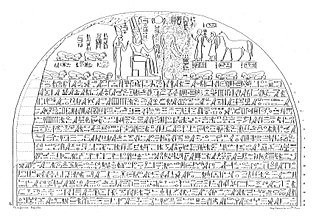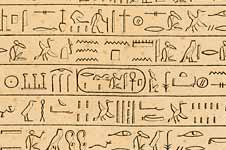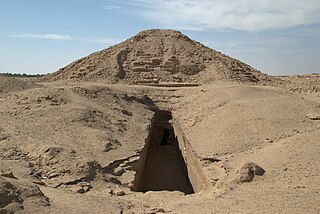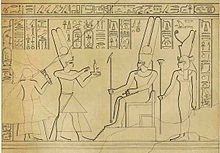
Piye was an ancient Kushite king and founder of the Twenty-fifth Dynasty of Egypt, who ruled Egypt from 744–714 BC. He ruled from the city of Napata, located deep in Nubia, modern-day Sudan.

Neferkare Shabaka, or Shabako was the third Kushite pharaoh of the Twenty-fifth Dynasty of Egypt, who reigned from 705 to 690 BC.
Tantamani, also known as Tanutamun or Tanwetamani was ruler of the Kingdom of Kush located in Northern Sudan, and the last pharaoh of the Twenty-fifth Dynasty of Egypt. His prenomen or royal name was Bakare, which means "Glorious is the Soul of Re."

Kashta was an 8th century BC king of the Kushite Dynasty in ancient Nubia and the successor of Alara. His nomen k3š-t3 "of the land of Kush" is often translated directly as "The Kushite". He was succeeded by Piye, who would go on to conquer ancient Egypt and establish the Twenty-Fifth Dynasty there.

Alara was a King of Kush, who is generally regarded as the founder of the Napatan royal dynasty by his 25th Dynasty Kushite successors and was the first recorded prince of Kush. He unified all of Upper Nubia from Meroë to the Third Cataract and is possibly attested at the Temple of Amun at Kawa. Alara also established Napata as the religious capital of Kush. Alara himself was not a 25th dynasty Kushite king since he never controlled any region of Egypt during his reign compared to his two immediate successors: Kashta and Piye respectively. Nubian literature credits him with a substantial reign since future Nubian kings requested that they might enjoy a reign as long as Alara's. His memory was also central to the origin myth of the Kushite kingdom, which was embellished with new elements over time. Alara was a deeply revered figure in Nubian culture and the first Kushite king whose name came down to scholars.

Iaret was a Great Royal Wife from the middle of the Eighteenth Dynasty of Ancient Egypt.

Nuri is a place in modern Sudan on the west side of the Nile, near the Fourth Cataract. Nuri is situated about 15 km north of Sanam, and 10 km from Jebel Barkal.

Atlanersa was a Kushite ruler of the Napatan kingdom of Nubia, reigning for about a decade in the mid-7th century BC. He was the successor of Tantamani, the last ruler of the 25th Dynasty of Egypt, and possibly a son of Taharqa or less likely of Tantamani, while his mother was a queen whose name is only partially preserved. Atlanersa's reign immediately followed the collapse of Nubian control over Egypt, which witnessed the Assyrian conquest of Egypt and then the beginning of the Late Period under Psamtik I. The same period also saw the progressive cultural integration of Egyptian beliefs by the Kushite civilization.

Isetnofret was a royal woman of Ancient Egypt and, as the Great Royal Wife of Pharaoh Merenptah, she became Isetnofret II.
Tabiry was a Nubian queen dated to the Twenty-fifth Dynasty of Egypt.

Takahatenamun was a Nubian queen dated to the Twenty-fifth Dynasty of Egypt.
Khensa (Khenensaiuw) was a Nubian queen dated to the Twenty-fifth Dynasty of Egypt.

El-Kurru was one of the royal cemeteries used by the Nubian royal family of Kush and Egypt's 25th Dynasty. It is now located in Northern state, Sudan. Excavated by George Reisner, most of the royal Nubian pyramids date to the early part of the Kushite period, from Alara of Nubia to King Nastasen.
Peksater (Pekerslo) was a Nubian queen dated to the Twenty-fifth Dynasty of Egypt.
Atakhebasken (Akhetbasaken) was a Nubian queen dated to the Twenty-fifth Dynasty of Egypt. She was the Great Royal Wife of Pharaoh Taharqa.
Naparaye was a Nubian queen dated to the Twenty-fifth Dynasty of Egypt.
Qalhata was a Nubian queen dated to the Twenty-fifth Dynasty of Egypt.

The Twenty-fifth Dynasty of Egypt, also known as the Nubian Dynasty, the Kushite Empire, the Black Pharaohs, or the Napatans after their capital Napata, was the last dynasty of the Third Intermediate Period of Egypt that occurred after the Nubian invasion.

Pebatjma was a Nubian queen dated to the Twenty-fifth Dynasty of Egypt. She was the wife of King Kashta. She is mentioned on a statue of her daughter Amenirdis I, now in Cairo (42198). She is also mentioned on a doorjamb from Abydos.

Nasalsa was a Nubian queen of the Kingdom of Kush dated to the Twenty-fifth Dynasty of Egypt. She is known from a shabti, some inscriptions on tablets and cups, text on the stela of Khaliut, a dedication inscription and a text from Kawa. Dodson mentions that Nasalsa is named on the Enthronement Stela of Atlanersa and on the Election and Adoption Stelae of Aspelta. These stelae were from Gebel Barkal.













